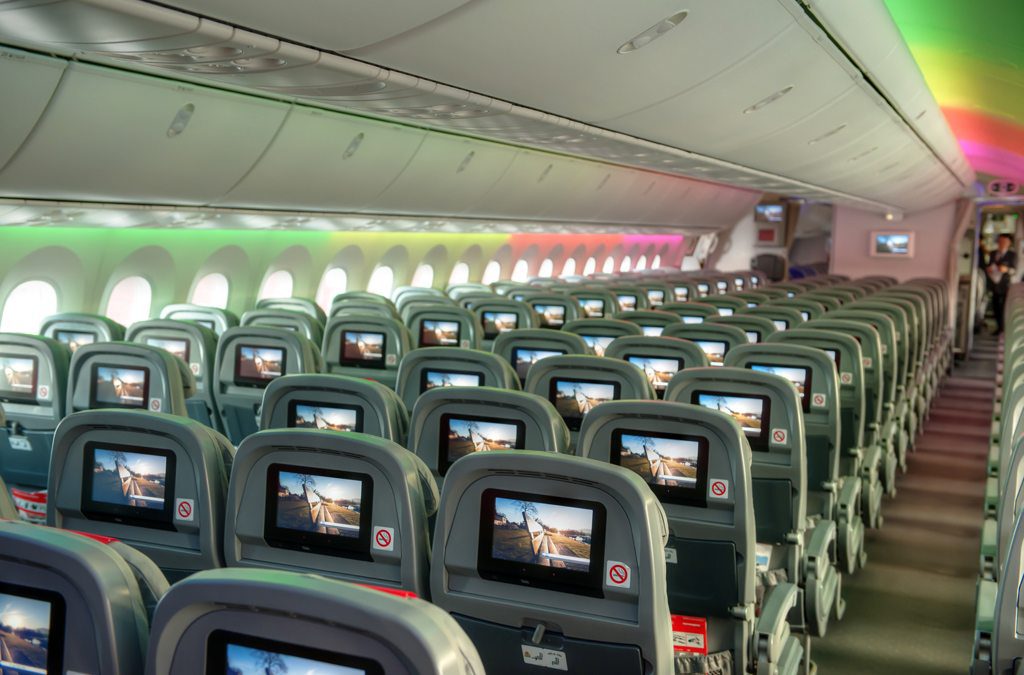Travelers Love Spunky Norwegian Air. But What About Investors?

Skift Take
Few no-frills airlines delight customers as much as Norwegian Air, the Oslo discounter challenging legacy carriers like American Airlines, United Airlines, British Airways, and Lufthansa on some of their most lucrative transatlantic routes. In an industry that has changed little over the past three decades, Norwegian is a disrupter.
Yes, it charges for nearly everything, including seat assignments and meals, but it's often so much cheaper than big airlines that passengers rarely complain. Travelers like how Norwegian flies new Boeing 787s with high-resolution in-seat screens and mood lighting on many longer routes. And unlike many discount airlines, which serve only larger cities, Norwegian not only flies from New York City and Los Angeles, but also from Hartford, Connecticut; Newburgh, New York; and Providence, Rhode Island, making it a convenient option for more travelers.
Still, not all is perfect at Norwegian, an airline that has won three consecutive awards for the world's best low-cost carrier, and maintains load factors of nearly 90 percent. While it has excelled at making passengers happy, the airline's profits have fallen as costs have increased, leading some investment analysts to question whether Norwegian has grown too quickly. They wonder if Norwegian can withstand competition from legacy carriers, especially since some larger airlines seem willing to lose money to thwart it.
Analysts had been concerned for awhile about Norwegian, and some expressed disappointment when CFO Frode Foss quit unexpectedly in early July after 15 years with the airline to "explore new ventures." But they were more spooked in mid-July when the airline announced second quarter earnings.
Norwegian's adjusted operating profit, before aircraft leasing and depreciation, fell 21 percent year-over-year, to roughly $144 million. It was less profit than most analysts had expected, and the airline blamed the dip on higher-than-expected costs, as well as sagging unit revenues. Its stock, which fell 8 percent after Foss left, and roughly 15 percent after the earnings announcement, is not worth significantly more than it was in 2013, when it was a smallish airline focused on European routes.
"Clearly the results were very substantially below where market consensus was," Andrew Lobbenberg, a London-based analyst at HSBC, told Skift in an interview. "It was a weak set of numbers and the share price reaction on the day told the story."
Or, as Hans-Marius Ludvigsen and Vetle Holt Johansen, two analysts at Swedbank in Norway, put it it in an email to Skift, "This report was just plain bad."
Rapid Growth Leads to Cost Creep
As recently as 2012, Norwegian was a low-profile discount airline with 68 narrowbody aircraft flying 308 routes — and none to the United States. It was a profitable airline, and it carried only 17.7 million passengers for the entire year.
Today, it's much larger. Last year, with 118 jets at December's end, Norwegian flew more than 29 million passengers on 472 routes. And it's on track for a bigger year in 2017: In the second quarter — a period in which it had 133 aircraft — it transported 8.6 million passengers, an increase of 12 percent, year-over-year.
The United States has been a major focus, and as of mid-July, Norwegian had 58 routes into the country, Kjos told analysts. "That's quite remarkable after three years, I think," he said. Increasingly, Norwegian is adding flights elsewhere. By early next year, from London it will fly as far east as Singapore, as far south as Buenos Aires and as far west as Los Angeles. It's also growing long-haul routes from Paris, Barcelona, and Rome, among other cities.
That growth is expensive. Any airline would have higher overall costs as it gets bigger, but Norwegian's unit costs are rising too, worrying analysts, since generally unit costs should decrease or remain steady as a company's scale increases.
"They are growing so very quickly that it is a significant challenge to manage costs and to manage the inflow of new staff to match the launch of new routes," Lobbenberg said.
For the second quarter, when overall operating expenses rose by 45 percent, the airline said unit costs increased 9 percent year-over-year. Higher fuel costs accounted for some of unit cost pressure — in part because Norway's currency has lost value against the U.S. dollar — but Norwegian also blamed personnel costs, sales and distribution expenses, and maintenance expenses. Swedebank's Ludvigsen and Johansen said the airline missed estimates on every cost element, calling it "worse than anticipated in every possible way."
Norwegian had some unusual expenses as a consequence of its growth. Earlier this year, it was forced to wet-lease an aircraft for New York flights, after one of its 787s sustained fuselage damage. Most airlines occasionally lose aircraft unexpectedly for maintenance, and carriers usually have spares. But Norwegian didn't, so it contracted with a carrier called Wamos Air, at a considerable cost.
Ludvigsen and Johansen said some expansion-related costs, like increased costs for pilot training, may eventually dissipate. But they can't say for sure. "The major concern is 'What if it doesn’t?'"
Still, Norwegian executives said they're not worried about creeping costs. "If you look on our unit cost comparison versus other airliners, we have a quite strong position versus other low-cost airliners," interim CFO Tore Ostby told analysts in July.
Revenue Issues
Undoubtedly, Norwegian is a disrupter, and often offers a better economy class and premium economy product at a lower price than many legacy carriers. But major airline companies like International Airlines Group, or IAG, owner of British Airways and Iberia, view Norwegian as a threat, and they're responding accordingly.
In many cases, they match Norwegian's prices, and in some, they've added flights where they compete with Norwegian. Competition from Norwegian is likely a major reason United Airlines will soon fly year-round from Newark to Rome, rather than seasonally.
Sometimes, big airlines are more aggressive. In June, IAG launched a new discount airline called Level to fly many of the same routes between Barcelona and the Americas as Norwegian. Meanwhile Air France is creating a new millennial-friendly airline called Joon, which may attract some Norwegian loyalists, even if Joon is technically not a low-cost carrier.
Competition is likely affecting Norwegian's finances. For the first half of the year, the airline reported that yield — a rough measure of income from ticket sales — fell 9 percent. Unit revenues also decreased 9 percent.
Lobbenberg said it might take time before revenues recover, saying it may depend on overall capacity in the market, and the strength of the global economy.
"And will also depend on how aggressive the legacy carriers are in competing against them," he said. "Clearly, as they are the biggest potential destabilizing influence on the North Atlantic, it is in the interest of the incumbent airlines to compete with them robustly."
Here, too, Norwegian is unconcerned. Lower fares, the airline noted to investors, give Norwegian access to more customers.
"A marketplace where capacity growth exceeds market growth will increase the risk of yield pressure," it said. "However, low yield stimulates new demand, thus growing the market further."
Too many narrowbody aircraft
Five years ago, Norwegian placed a massive order for two aircraft with similar capabilities, committing to 100 Boeing 737 Maxes, and 100 Airbus A320neos. It was a curious order, since few thought Norwegian needed all the aircraft.
But Norwegian had other plans. It created an aircraft leasing business, and it's renting some A320neos to other airlines. Aircraft leasing can be profitable for companies that focus on it, but there's some question about whether it's the right business for Norwegian, which calls its leasing group Arctic Aviation Asset Ltd.
"It's incredibly rare," Lobbenberg said. "It's a recognition, or perhaps it's a consequence of the fact that, with the benefit of hindsight, they've ordered more aircraft than they should have done."
One issue, Lobbenberg said, is that Norwegian does not have the same access to capital as a massive aircraft leasing company like GE Capital Aviation Services. "Norwegian Air Shuttle, their balance sheet is very highly levered," Lobbenberg said. "And that ill places them to compete with other powerhouses on the strength of their balance sheet. Which makes them ill-placed to be a natural lessor."
There's another problem with the A320neo. Eventually, it should prove a popular plane, because of its fuel efficiency. But engine maker Pratt and Whitney is struggling with the engine reliability issues, making Norwegian's aircraft less valuable.
"When the engine runs trouble-free, the impressive fuel performance ... is what the market will remember," Bjorn Fehrm, an aviation analyst, wrote in Leeham News and Comment, a respected industry website. "But right now, the engine is a challenge to operations. Therefore, it will be difficult to place Norwegian’s A320neos with reasonable lease rates for at least the next 12 months."
Will it Survive?
For all the criticisms, no one is suggesting Norwegian will go out of business, or even that the airline might never regain its footing. With its low-cost model, it should be able to survive, and even thrive, satisfying passengers with sub-$99 one-way fares between the United States and Europe.
And while growing more slowly might have helped Norwegian produce better financial results, Ludvigsen and Johansen say they're not sure that would have been the right approach. Scale, they note, is vital in the airline business.
"Norwegian is operating a business where reaching a critical mass is key for success, and thus the growth ambitions have probably been justified from the start," they said. "Unfortunately for the company, the developments along the way have created significant uncertainty, but you've got to risk it to get the biscuit in these kinds of businesses."
Lobbenberg said he's not sure how or when Norwegian's finances will rebound, but he acknowledged it's disrupting the transatlantic market in a passenger-friendly manner.
"There's no doubt that they are a very consumer-friendly business," he said "They are highly innovative. They are shaping the industry, no? They've got the American majors extremely wound up about what this relatively small company from Norway is doing."





